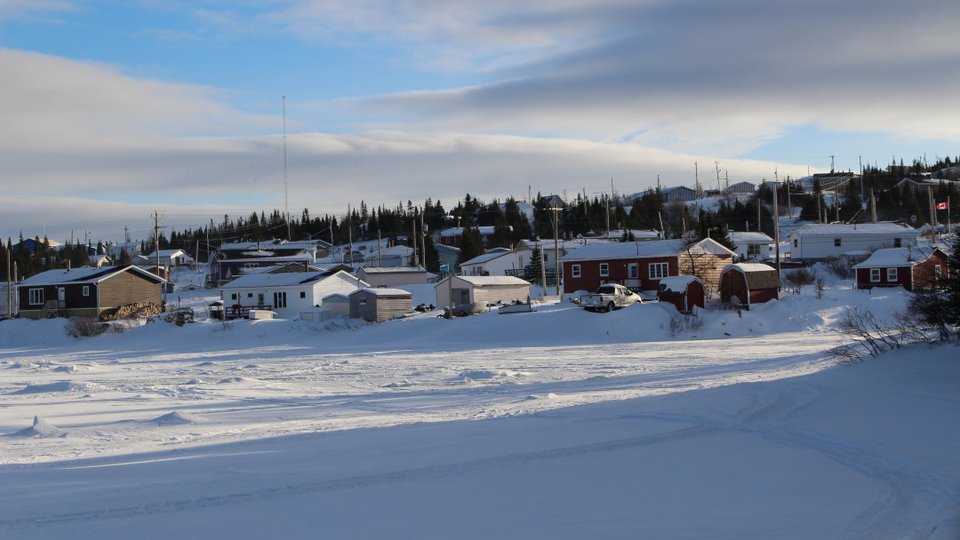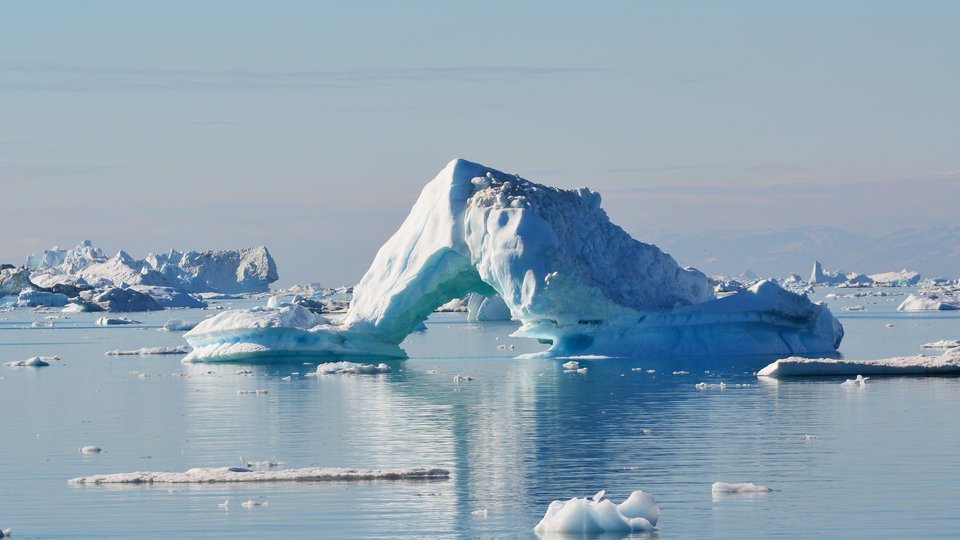
At just over 14 million square kilometres, the Arctic Ocean is the smallest and shallowest of the world’s oceans. It is also the coldest. An expansive raft of sea ice floats near its centre, expanding in the long, cold, dark winter, and contracting in the summer, as the Sun climbs higher in the sky.
Every year, usually in September, the sea ice cover shrinks to its lowest level. The tally in 2020 was a meagre 3.74 million square kilometres, the second-smallest measurement in 42 years, and roughly half of what it was in 1980. Each year, as the climate warms, the Arctic is holding onto less and less ice.
The effects of global warming are being felt around the world, but nowhere on Earth are they as dramatic as they are in the Arctic. The Arctic is warming two to three times faster than any other place on Earth, ushering in far-reaching changes to the Arctic Ocean, its ecosystems and the 4 million people who live in the Arctic.
Some of them are unexpected. The warmer water is pulling some species further north, into higher latitudes. The thinner ice is carrying more people through the Arctic on cruise ships, cargo ships and research vessels. Ice and snow can almost entirely black out the water beneath it, but climate change is allowing more light to flood in.
Artificial light in the polar night
Light is very important in the Arctic. The algae which form the foundation of the Arctic Ocean’s food web convert sunlight into sugar and fat, feeding fish and, ultimately, whales, polar bears and humans.At high latitudes in the Arctic during the depths of winter, the Sun stays below the horizon for 24 hours. This is called the polar night, and at the North Pole, the year is simply one day lasting six months, followed by one equally long night.Researchers studying the effects of ice loss deployed moored observatories – anchored instruments with a buoy — in an Arctic fjord in the autumn of 2006, before the fjord froze. When sampling started in the spring of 2007, the moorings had been in place for almost six months, collecting data throughout the long and bitter polar night.What they detected changed everything.

The polar night can last for weeks and even months in the high Arctic. (Photo: Michael O. Snyder, Author provided)
Life in the dark
At that time, scientists assumed the polar night was utterly uninteresting. A dead period in which life lies dormant and the ecosystem sinks into a dark and frigid standby mode. Not much was expected to come of these measurements, so researchers were surprised when the data showed that life doesn’t pause at all.
Arctic zooplankton — tiny microscopic animals that eat algae — take part in something called diel vertical migration beneath the ice and in the dead of the polar night. Sea creatures in all the oceans of the world do this, migrating to depth during the day to hide from potential predators in the dark, and surfacing at night to feed.
Organisms use light as a cue to do this, so they shouldn’t logically be able to during the polar night. We now understand the polar night to be a riot of ecological activity. The normal rhythms of daily life continue in the gloom. Clams open and close cyclically, seabirds hunt in almost total darkness, ghost shrimps and sea snails gather in kelp forests to reproduce, and deep-water species such as the helmet jellyfish surface when it’s dark enough to stay safe from predators.
For most of the organisms active during this period, the Moon, stars and aurora borealis likely give important cues that guide their behaviour, especially in parts of the Arctic not covered by sea ice. But as the Arctic climate warms and human activities in the region ramp up, these natural light sources will in many places be invisible, crowded out by much stronger artificial light.

The northern lights dance in the sky over Tromsø, Norway. (Photo: Muratart/Shutterstock)
Artificial light
Almost a quarter of all land masses are exposed to scattered artificial light at night, as it’s reflected back to the ground from the atmosphere. Few truly dark places remain, and light from cities, coastlines, roads and ships is visible as far as outer space.
Even in sparsely populated areas of the Arctic, light pollution is noticeable. Shipping routes, oil and gas exploration and fisheries extend into the region as the sea ice retreats, drawing artificial light into the otherwise inky black polar night.

Creatures which have adapted to the polar night over millions of years are now suddenly exposed to artificial light. (Photo: Michael O. Snyder, Author provided)
No organisms have had the opportunity to properly adapt to these changes – evolution works on a much longer timescale. Meanwhile, the harmonic movements of the Earth, Moon and Sun have provided reliable cues to Arctic animals for millennia. Many biological events, such as migration, foraging and breeding are highly attuned to their gentle predictability.
In a recent study carried out in the high Arctic archipelago of Svalbard, between mainland Norway and the north pole, the onboard lights of a research vessel were found to affect fish and zooplankton at least 200 metres down. Disturbed by the sudden intrusion of light, the creatures swirling beneath the surface reacted dramatically, with some swimming towards the beam, and others swimming violently away.
It’s difficult to predict the effect artificial light from ships newly navigating the ice-free Arctic will have on polar night ecosystems that have known darkness for longer than modern humans have existed. How the rapidly growing human presence in the Arctic will affect the ecosystem is concerning, but there are also unpleasant questions for researchers. If much of the information we’ve gathered about the Arctic came from scientists stationed on brightly lit boats, how “natural” is the state of the ecosystem we have reported?
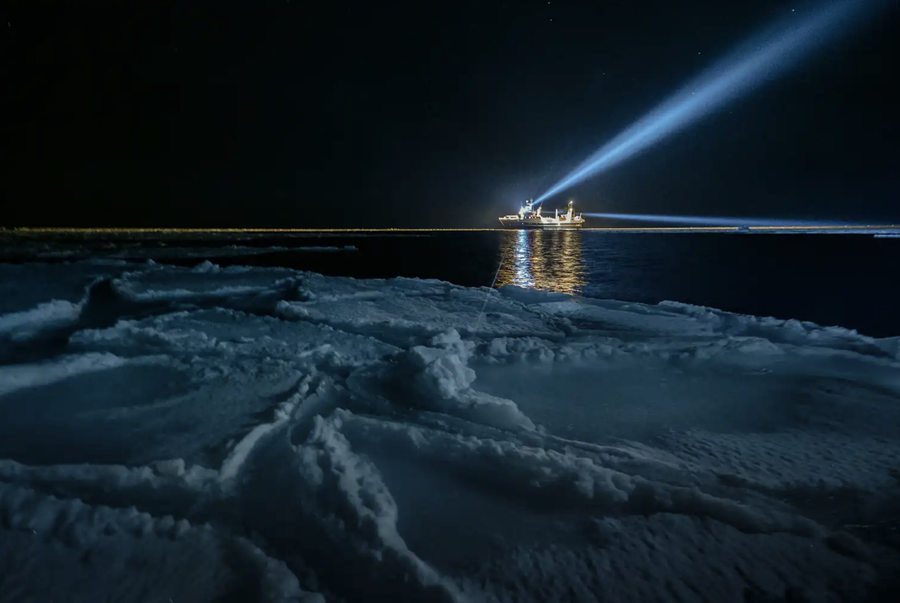
Research in the Arctic could change considerably over the coming years to reduce light pollution. (Photo: Michael O. Snyder, Author provided)
Arctic marine science is about to enter a new era with autonomous and remotely operated platforms, capable of operating without any light, making measurements in complete darkness.
Underwater forests
As sea ice retreats from the shores of Greenland, Norway, North America and Russia, periods with open water are getting longer, and more light is reaching the sea floor. Suddenly, coastal ecosystems that have been hidden under ice for 200,000 years are seeing the light of day. This could be very good news for marine plants like kelp – large brown seaweeds that thrive in cold water with enough light and nutrients.
Anchored to the sea floor and floating with the tide and currents, some species of kelp can grow up to 50 metres (175 feet) – about the same height as Nelson’s Column in Trafalgar Square, London. But kelp are typically excluded from the highest latitudes because of the shade cast by sea ice and its scouring effect on the seabed.
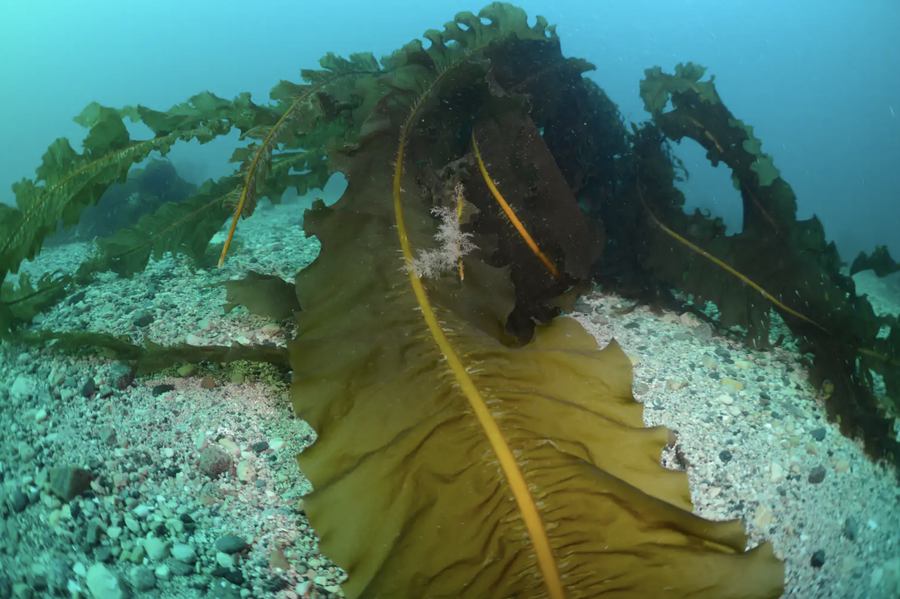
Badderlocks, or winged kelp, off the coast of Nunavut in the Canadian Arctic. (Photo: Ignacio Garrido/ArcticKelp, Author provided)
These lush underwater forests are set to grow and thrive as sea ice shrinks. Kelp are not a new arrival to the Arctic though. They were once part of the traditional Greenlandic diet, and polar researchers and explorers observed them along northern coasts more than a century ago.
Some species of kelp may have colonised Arctic coasts after the last ice age, or spread out from small pockets where they’d held on. But most kelp forests in the Arctic are smaller and more restricted to patches in deeper waters, compared to the vast swathes of seaweed that line coasts like California’s in the US.
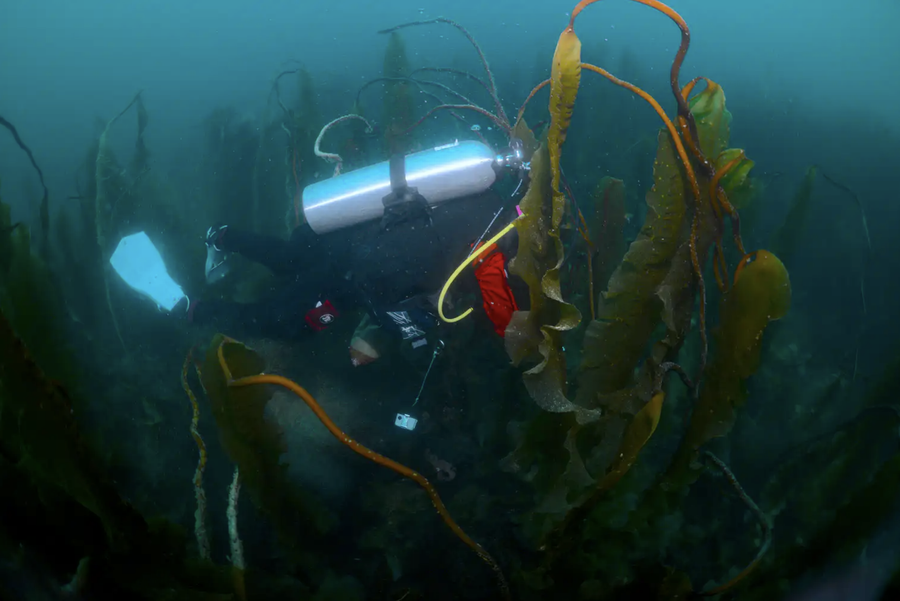
A diver explores a four-metre-high sugar kelp forest off Southampton Island, Canada. (Photo: Ignacio Garrido/ArcticKelp, Author provided)
Recent evidence from Norway and Greenland shows kelp forests are already expanding and increasing their ranges poleward, and these ocean plants are expected to get bigger and grow faster as the Arctic warms, creating more nooks for species to live in and around. The full extent of Arctic kelp forests remains largely unseen and uncharted, but modelling can help determine how much they have shifted and grown in the Arctic since the 1950s.
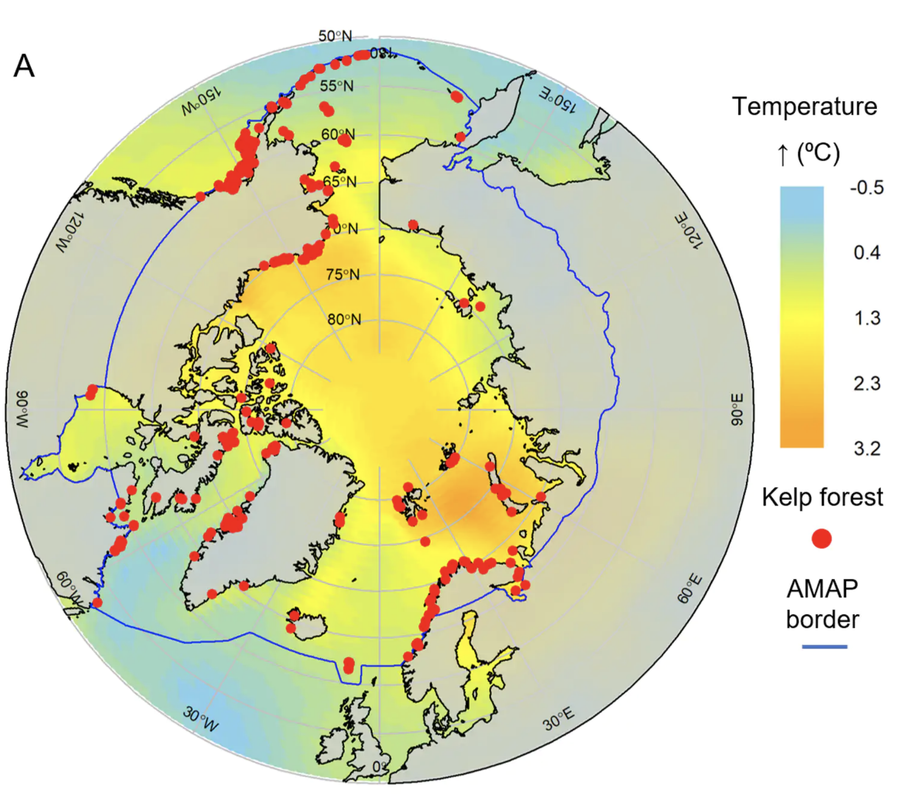
Known locations of kelp forests and global trends in predicted average summer surface temperature increase over next two decades, according to IPCC models. (Photo: Filbee-Dexter et al. (2018), Author provided)
A new carbon sink
Although large seaweeds come in all shapes and sizes, many are remarkably similar to trees, with long, trunk-like but flexible bodies called stipes. The kelp forest canopy is filled with the flat blades like leaves, while holdfasts act like roots by anchoring the seaweed to rocks below.
Some types of Arctic kelp can grow over ten metres and form large and complex canopies suspended in the water column, with a shaded and protected understorey. Much like forests on land, these marine forests provide habitats, nursery areas and feeding grounds for many animals and fish, including cod, pollack, crabs, lobsters and sea urchins.
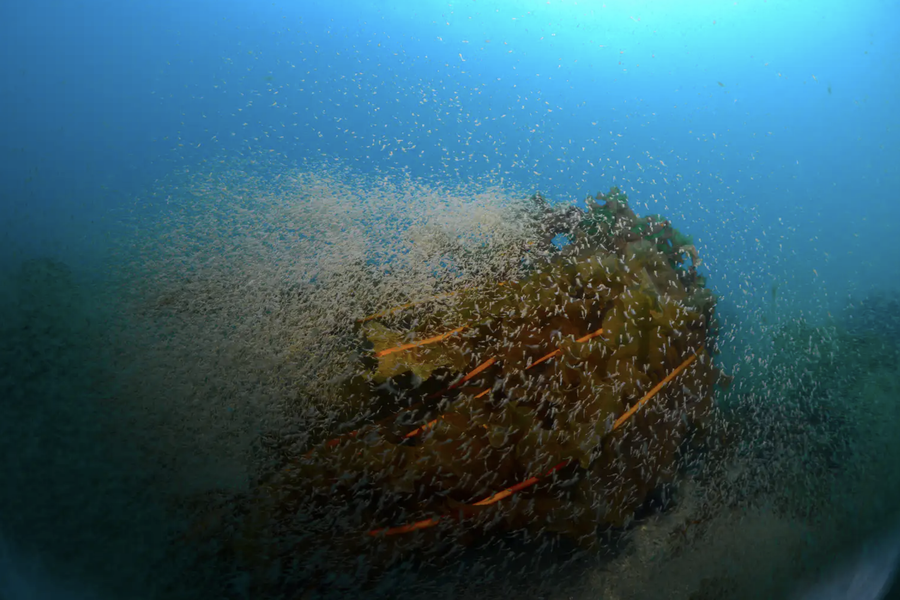
Kelp forests offer lots of nooks and crannies and surfaces to settle on, making them rich in wildlife. (Photo: Ignacio Garrido/ArcticKelp, Author provided)
Kelp are fast growers, storing carbon in their leathery tissue as they do. So what does their expansion in the Arctic mean for the global climate? Like restoring forests on land, growing underwater kelp forests can help to slow climate change by diverting carbon from the atmosphere.
Better yet, some kelp material breaks off and is swept out of shallow coastal waters and into the deep ocean where it’s effectively removed from the Earth’s carbon cycle. Expanding kelp forests along the Earth’s extensive Arctic coasts could become a growing carbon sink that captures the CO₂ humans emit and locks it away in the deep sea.
What’s happening with kelp in the Arctic is fairly unique – these ocean forests are embattled in most other parts of the world. Overall, the global extent of kelp forests is on a downward trend because of ocean heatwaves, pollution, warming temperatures, and outbreaks of grazers like sea urchins.
Unsurprisingly, it’s not all good news. Encroaching kelp forests could push out unique wildlife in the high Arctic. Algae living under the ice will have nowhere to go, and could disappear altogether. More temperate kelp species may replace endemic Arctic kelps such as Laminaria solidungula.
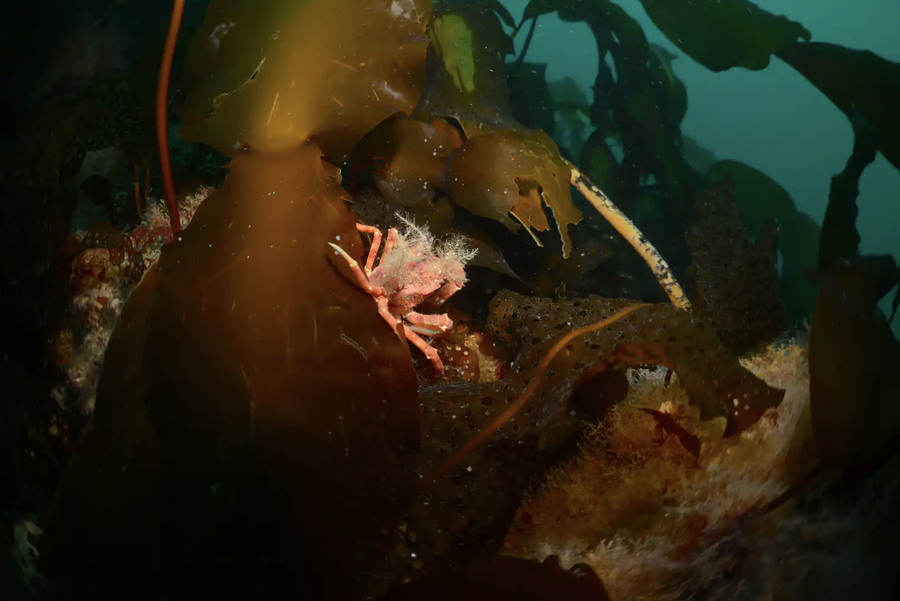
A crab finds refuge on Laminaria solidungula – the only kelp species endemic to the Arctic. (Photo: Ignacio Garrido/ArcticKelp, Author provided)
But kelp are just one set of species among many pushing further and deeper into the region as the ice melts.
Arctic invasions
Milne Inlet, on north Baffin Island, Nunavut, Canada, sees more marine traffic than any other port in Arctic Canada. Most days during the open-water period, 300-metre-long ships leave the port laden with iron ore from the nearby Mary River Mine. Between 71 and 82 ships pass through the area annually, most heading to — or coming from ports in northern Europe.
Cruise ships, coast guard vessels, pleasure yachts, research icebreakers, cargo supply ships and rigid inflatable boats full of tourists also glide through the area. Unprecedented warming and declining sea ice has attracted new industries and other activities to the Arctic. Communities like Pond Inlet have seen marine traffic triple in the past two decades.

Passengers from a cruise ship arrive in Pond Inlet, Nunavut. (Photo: Kimberly Howland, Author provided)
These ships come to the Arctic from all over the world, carrying a host of aquatic hitchhikers picked up in Rotterdam, Hamburg, Dunkirk and elsewhere. These species — some too small to see with the naked eye — are hidden in the ballast water pumped into on-board tanks to stabilise the ship. They also stick to the hull and other outer surfaces, called “biofouling.”
Some survive the voyage to the Arctic and are released into the environment when the ballast water is discharged and cargo loaded. Those that maintain their hold on the outer surface may release eggs, sperm or larvae.
Many of these organisms are innocuous, but some may be invasive newcomers that can cause harm. Research in Canada and Norway has already shown non-native invasive species like bay and acorn barnacles can survive ship transits to the Arctic. This raises a risk for Arctic ecosystems given that invasive species are one of the top causes for extinctions worldwide.
Expanded routes
Concern about invasive species extends far beyond the community of Pond Inlet. Around 4 million people live in the Arctic, many of them along the coasts that provide nutrients and critical habitat for a wide array of animals, from Arctic char and ringed seals to polar bear, bowhead whales and millions of migratory birds.
As waters warm, the shipping season is becoming longer, and new routes, like the Northwest Passage and the Northern Sea Route (along Russia’s Arctic coast), are opening up. Some researchers expect a trans-Arctic route across the North Pole might be navigable by mid-century. The increased ship traffic magnifies the numbers and kinds of organisms transported into Arctic waters, and the progressively more hospitable conditions improve their odds of survival.
Prevention is the number one way to keep invasive species out of the Arctic. Most ships must treat their ballast water, using chemicals or other processes, and/or exchange it to limit the movement of harmful organisms to new locations. Guidelines also recommend ships use special coatings on the hulls and clean them regularly to prevent biofouling. But these prevention measures are not always reliable, and their efficacy in colder environments is poorly understood.
The next best approach is to detect invaders as soon as possible once they arrive, to improve chances for eradication or suppression. But early detection requires widespread monitoring, which can be challenging in the Arctic. Keeping an eye out for the arrival of a new species can be akin to searching for a needle in a haystack, but northern communities may offer a solution.
Researchers in Norway, Alaska and Canada have found a way to make that search easier by singling out species that have caused harm elsewhere and that could endure Arctic environmental conditions. Nearly two dozen potential invaders show a high chance for taking hold in Arctic Canada.

The red king crab was intentionally introduced to the Barents Sea in the 1960s, but is now spreading south along the Norwegian coast. (Photo: Shutterstock)
Among these is the cold-adapted red king crab, native to the Sea of Japan, Bering Sea and North Pacific. It was intentionally introduced to the Barents Sea in the 1960s to establish a fishery and is now spreading south along the Norwegian coast and in the White Sea. It is a large, voracious predator implicated in substantial declines of harvested shellfish, sea urchins and other larger, slow moving bottom species, with a high likelihood of surviving transport in ballast water.
Another is the common periwinkle, which ruthlessly grazes on lush aquatic plants in shoreline habitats, leaving behind bare or encrusted rock. It has also introduced a parasite on the east coast of North America that causes black spot disease in fishes, which stresses adult fishes and makes them unpalatable, kills juveniles and causes intestinal damage to birds and mammals that eat them.
Tracking genetic remnants
New species like these could affect the fish and mammals people hunt and eat, if they were to arrive in Pond Inlet. After just a few years of shipping, a handful of possibly non-native species have already been discovered, including the invasive red-gilled mudworm (Marenzellaria viridis), and a potentially invasive tube dwelling amphipod. Both are known to reach high densities, alter the characteristics of the seafloor sediment and compete with native species.

A cargo ship passes through Milne Inlet, Nunavut. (Photo: Kimberly Howland, Author provided)
Baffinland, the company that runs the Mary River Mine, is seeking to double its annual output of iron ore. If the expansion proceeds, up to 176 ore carriers will pass through Milne Inlet during the open-water season.
Although the future of Arctic shipping remains uncertain, it’s an upward trend that needs to be watched. In Canada, researchers are working with Indigenous partners in communities with high shipping activity — including Churchill, Manitoba; Pond Inlet and Iqaluit in Nunavut; Salluit, Quebec and Nain, Newfoundland — to establish an invasive species monitoring network. One of the approaches includes collecting water and testing it for genetic remnants shed from scales, faeces, sperm and other biological material.
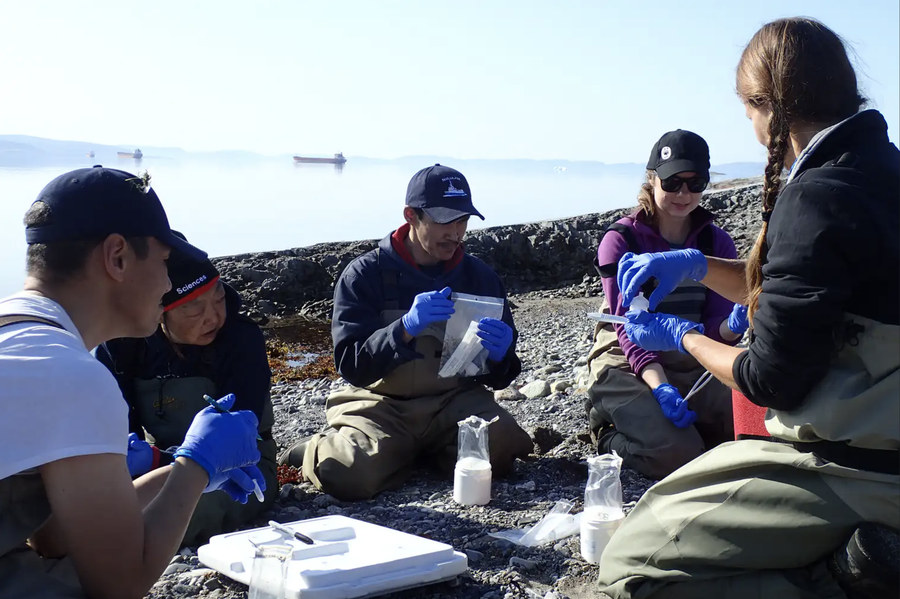
Members of the 2019 field team from Pond Inlet and Salluit filter eDNA from water samples collected from Milne Inlet. (Photo: Christopher Mckindsey, Author provided)
This environmental DNA (eDNA) is easy to collect and can help detect organisms that might otherwise be difficult to capture or are in low abundance. The technique has also improved baseline knowledge of coastal biodiversity in other areas of high shipping, a fundamental step in detecting future change.
Some non-native species have already been detected in the Port of Churchill using eDNA surveillance and other sampling methods, including jellyfish, rainbow smelt and an invasive copepod species.
Efforts are underway to expand the network across the Arctic as part of the Arctic Council’s Arctic Invasive Alien Species Strategy to reduce the spread of invasive species.
The Arctic is often called the frontline of the climate crisis, and because of its rapid rate of warming, the region is beset by invasions of all kinds, from new species to new shipping routes. These forces could entirely remake the ocean basin within the lifetimes of people alive today, from frozen, star-lit vistas, populated by unique communities of highly adapted organisms, to something quite different.
The Arctic is changing faster than scientists can document, yet there will be opportunities, such as growing carbon sinks, that could benefit the wildlife and people who live there. Not all changes to our warming world will be wholly negative. In the Arctic, as elsewhere, there are winners and losers.

This article originally appeared in The Conversation

